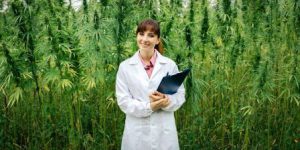By Jen Johnston, CHHC, senior marketing services account manager, for the Step into Natural blog series
Is CBD on your radar? CBD – short for cannabidiol – is oil from the cannabis plant that, unlike another well-known oil (THC), does not make a person high. It is, however, purported to help with a number of conditions including those as serious as seizures, but also inflammation, anxiety, and sleep problems.
The oil was recently approved for use in EPIDIOLEX®, a prescription medicine that is used to treat seizures associated with Lennox-Gastaut syndrome or Dravet syndrome. But there are many over-the-counter products that contain hemp-derived CBD, particularly since the passing of the 2018 Farm Bill. The Farm Bill federally legalized the cultivation and sale of industrial hemp, which is defined as cannabis that contains less than 0.3-percent THC.
It is important to note that FDA has clearly stated products containing CBD cannot be sold as dietary supplements and it’s not legal in interstate commerce to sell a food to which CBD has been added. This is because GW Pharmaceuticals had filed a new drug application for EPIDIOLEX and  clinical investigations were made public before CBD was sold in the United States as a dietary supplement. However, the FDA has authority to issue a regulation allowing the use of a pharmaceutical ingredient in a food or dietary supplement and is going to hold a public meeting soon which may make things more clear.
clinical investigations were made public before CBD was sold in the United States as a dietary supplement. However, the FDA has authority to issue a regulation allowing the use of a pharmaceutical ingredient in a food or dietary supplement and is going to hold a public meeting soon which may make things more clear.
In the meantime, a Consumer Reports survey shows that 13% of Americans say they have used a CBD product and 90% of them claimed it helped treat their medical condition.
Despite the legal gray zone it has been in, CBD is big business. Elements, a publication for the independent pharmacy audience, recently reported the CBD market reached $500 million in 2018 and that the market may soon be in the billions.
The market is comprised of more than the standard oil tinctures, capsules, vapes, and sprays. CBD is popping up in many personal care products: lotions, creams, hair care, personal lubricant, bath bombs, makeup, bath salts, lip balms, and soaps.
Food and beverage is another area ripe for the infusion of CBD. There are currently ice teas, ice creams, salads, milk, and even children’s cereal with hemp ingredients including CBD oil, powders, and seeds, according to FoodDive.com.
OTC products may be the next to see the introduction of CBD as there are now CBD-infused transdermal patches, relief creams, and muscle freeze being sold online.
To counsel patients on CBD it is important to learn the science of the endocannabinoid system for yourself. Look for CEs on the topic or educational information from the supplier. There is no standard dosing, but often the manufacturers have recommendations. Despite its reputation as a “natural” product, CBD can interact with other drugs. Pharmacists should understand what other medications a patient is taking before they start taking CBD.
So, how can you know which companies are reputable? Elements suggests making sure your supplier can provide a certificate of analysis for each batch of products to verify its purity and its THC level. Ask to see the supplier’s license with the state agriculture department or university operating under a pilot program.
Don’t miss out on this important, growing CBD marketplace. Patients of all ages and walks of life are interested in CBD – be their source for honest, reputable information and for the product itself.